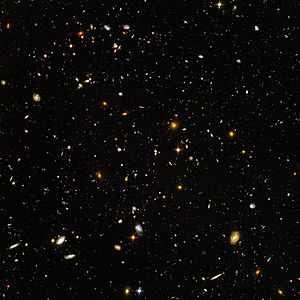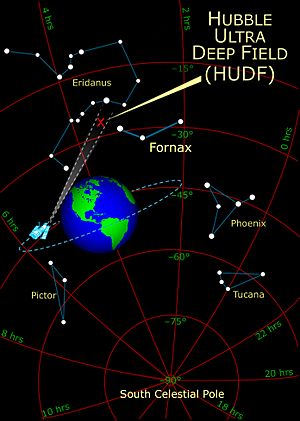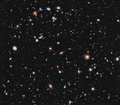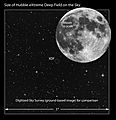Hubble Ultra Deep Field facts for kids
The Hubble Ultra Deep Field, or HUDF, is an amazing picture of a tiny part of outer space. It's located in the constellation called Fornax.
This incredible image took more than three months to capture. The Hubble Space Telescope worked from September 24, 2003, to January 16, 2004, to gather all the light. It's one of the deepest and farthest views of the universe ever taken by humans. When we look at the HUDF, we are seeing the universe as it was about 13 billion years ago. This was when the universe was very young, only about 800 million years old!
The HUDF picture shows about 10,000 galaxies. Scientists chose this specific spot in the sky because it doesn't have many bright stars close by. This allowed Hubble to see the faint, distant galaxies more clearly. While some of these distant objects can also be seen using infrared telescopes on Earth, Hubble is special. It's the only telescope that can see these very far-away galaxies using visible light.
Contents
What is the Hubble Ultra Deep Field?
The Hubble Ultra Deep Field is like a tiny window into the early universe. Imagine holding a 1 mm by 1 mm piece of paper one meter away from your eye. The area of sky that the HUDF covers is even smaller than that! It's about one thirteen-millionth of the entire sky.
This small patch of sky is found in the Southern Hemisphere. It is southwest of the Orion constellation, in Fornax.
How was the HUDF image made?
To create the HUDF, the Hubble Space Telescope took 800 separate pictures. These pictures were taken over 400 times that Hubble orbited Earth.
The telescope used two main cameras for this project. The Advanced Camera for Surveys (ACS) spent 11.3 days collecting light. The Near Infrared Camera and Multi-Object Spectrometer (NICMOS) worked for 4.5 days. All this effort combined to create the stunning image we see today.
Related pages
Images for kids
-
The size of the XDF compared with the size of the Moon
See also
 In Spanish: Campo ultraprofundo del Hubble para niños
In Spanish: Campo ultraprofundo del Hubble para niños






